Aloiampelos tenuior
Aloiampelos tenuior (Haw.) Klopper & Gideon F.Sm. (= Aloe tenuior Haw.)
Family: Asphodelaceae
Common names: fence aloe, slender aloe (Eng.); heiningaalwyn (Afr.); ikhalana, ikalene, intelezi, impapane, umjinqa, umkrakrane (isiXhosa); inhlaba, inhlaba empofu (isiZulu)
Introduction
This rambling aloe forms large clumps topped with masses of delicate, yellow or red flowerheads in summer, and is a useful and undemanding landscape plant. It was previously called Aloe tenuior.

Description
Description
Aloiampelos tenuior is a small to medium-sized, sprawling, bushy shrublet, with a large woody rootstock. It has slender, branching, semi-woody stems, up to 3 m long, that grow upright, but as they grow longer, they tend to need support from surrounding shrubs to remain erect. In time, the plant develops into a mass of intertwined stems, up to about 1.5 m tall with a spread of up to 1.8 m. The leaves are thin to slightly fleshy, blue-green (glaucous), unspotted, and are crowded in lax rosettes at the ends of branches. The leaf margins have small teeth.
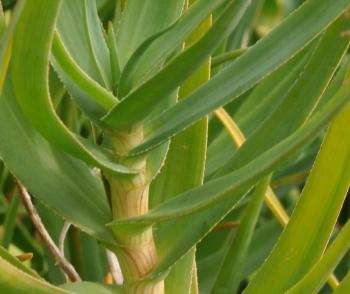
Flowers are borne in slender racemes and may be red, orange-red or yellow. Each flower is small, 10–19 mm long, narrow, about 4 mm in diameter, nodding, cylindric with a slightly expanded mouth through which the anthers and style protrude. Flowering occurs throughout the year, but mainly from late winter (August) through summer into autum (April–May).
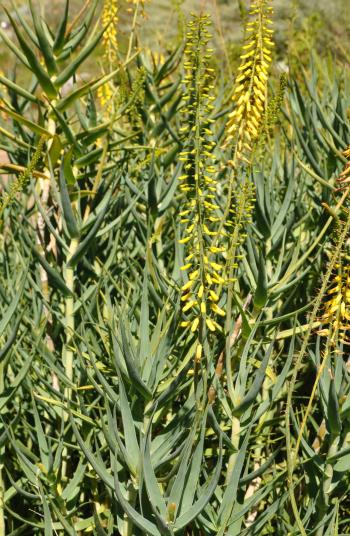
Conservation Status
Status
Least Concern (LC). This species is widespread, common, with a stable population and is not threatened.
Distribution and habitat
Distribution description
Aloiampelos tenuior occurs in open grassland, shrubland, wooded areas, thicket, coastal scrub, forest margins, rarely in valley bushveld, usually on sandy soils, in the Western Cape, Eastern Cape, KwaZulu-Natal and Mpumalanga. It is widespread in the Eastern Cape and southern KwaZulu-Natal between Somerset East, Cookhouse and Tsolo, with a disjunct population on the border between KwaZulu-Natal, Mpumalanga and Swaziland. It occurs from sea level to 2 300 m altitude.
Derivation of name and historical aspects
History
The genus name Aloiampelos meaning ‘climbing aloe’ is from Aloe and the Greek word, ampelos, meaning ‘climbing plant’, referring to the climbing or rambling habit of this group of aloes. Aloe comes from the Greek word for the dried juice of aloe leaves, which in turn was derived from earlier Sanskrit and Semitic words. The name tenuior meaning ‘more slender’, derived from the Latin word tenuis meaning ‘thin’, ‘fine’, ‘slim’ or ‘slender’. The name was given because it is more slender than its closest and most similar relatives A. ciliaris and A. striatula.
This aloe was introduced to Kew Gardens, by Bowie in 1812.
The genus Aloe was reclassified in 2013, the old broadly circumscribed genus has given way to a narrower generic concept for Aloe and two new genera are now recognised: the rambling aloes Aloiampelos and the tree aloes Aloidendron.
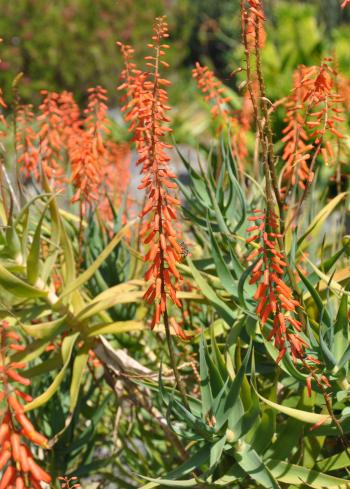
In the past, a number of subspecies were described: var. decidua, var. densiflora, var. glaucescens, var. rubriflora and var. viridiflora; but none of these are recognised at present, and are regarded as extreme variations of a highly variable species. The var. decidua from the Somerset East District, Fort Beaufort, Alice and Grahamstown that loses its leaves in winter; var. densiflora with more densely flowered racemes from the area around Alice and Breakfast Vlei; var. glaucescens with more bluish leaves from the Kei River; var. rubriflora a rare form with red flowers from Pondoland; and var. viridiflora a rare form with green leaves from north of Port Elizabeth.
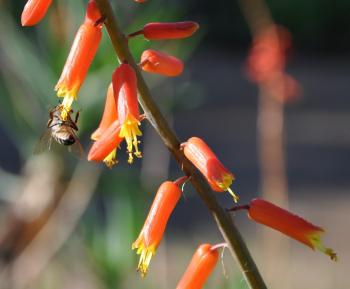
Ecology
Ecology
Aloiampelos tenuior flowers are visited by bees for their pollen and nectar and are the main pollinators. The 2014 study by Duffy, Johnson and Peter, showed that Aloiampelos tenuior needs a pollinator in order to set seed and its flowers are self-incompatible. It also found that birds do not visit the flowers and the main floral visitors are bees and butterflies, with honeybees being the most frequent, followed by solitary bees. Bees were found to carry more pollen than butterflies. The bees forage for pollen in the morning and early afternoon and for nectar in the late afternoon. More bees visit in the morning to harvest the pollen, and those that visit for nectar in the afternoon ensure that cross-pollination occurs. Bees return to more rewarding flowers more frequently, thus increasing the chances of successful transfer of pollen.
At Kirstenbosch, which is well outside of its natural range, honeybees, various beetles and the local sunbirds are seen feeding on the flowers.
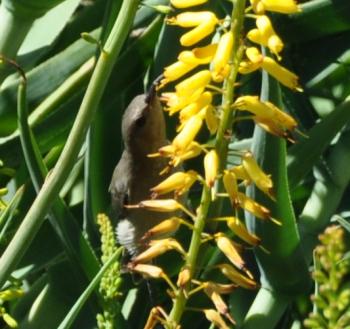
Uses
Use
The roots and leaves are used in traditional medicine as a purgative and tapeworm remedy. A bath taken in the foam of the leaves is believed to be a powerful charm to ensure good luck. Leaf infusions are also used as protective sprinkling charms.
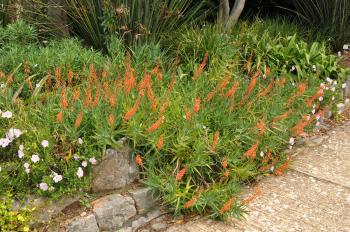
Growing Aloiampelos tenuior
Grow
Aloiampelos tenuior is easy to grow and is an undemanding, free-flowering garden plant. It grows best in well-drained soil enriched with compost, and while it can withstand dry conditions, it will perform better with regular watering. It needs a position in full sun, or one that receives sun for most of the day. Although it will grow in the shade, it will not flower. It needs protection from frost, but should withstand light frosts.
With its long flowering season and free-flowering habit in cultivation, it is a showy garden plant and a useful landscaping plant. It is well suited to rockeries, retaining walls, terraces and embankments, as well as mixed beds and borders; can be or planted en masse to cover a large area, and it can be encouraged to climb up fences and trellises, but it will need to be supported. It is also suitable for containers.
Aloiampelos tenuior grows easily from stem cuttings which should be allowed to dry for a few days and then can be rooted in well-drained potting soil or planted directly into the garden and kept moist, but not wet. There is no need for bottom heat, misting or rooting hormone.
Aloes are prone to a number of diseases and pests, the commonest of which are white scale and the aloe snout beetle. These can be treated with the appropriate insecticides.
References
- Batten, A. & Bokelmann, H. 1975. Wildflowers of the Eastern Cape Province. Cape and Transvaal Printers Ltd., Cape Town.
- Dold, A.P. & Cocks, M.L. 1999. Preliminary list of Xhosa plant names from the Eastern Cape, South Africa. Bothalia 29,2: 267-292.
- Duffy K.J., Johnson S.D. & Peter, C.I. 2014. A temporal dimension to the influence of pollen rewards on bee behaviour and fecundity in Aloe tenuior. PLoS ONE 9(4): e94908. doi:10.1371/journal.pone.0094908
- Foden, W. & Potter, L. 2009. Aloiampelos tenuior (Haw.) Klopper & Gideon F.Sm. National Assessment: Red List of South African Plants version 2015.1. Accessed on 2016/02/04
- Grace, O.M., Klopper, R., Smith, G.F., Crouch, N.R., Figueiredo, E., RØnsted, N.E. & Van Wyk, A.E. 2013. A revised generic classification for Aloe (Xanthorrhoeaceae subfam. Asphodeloideae). Phytotaxa 76,1: 7–14.
- Manning, J. 2001. Eastern Cape wild flower guide. Botanical Society of South Africa, Cape Town.
- Pooley, E. 1998. A field guide to wild flowers Kwazulu-Natal and the eastern region. Natal Flora Publications Trust, Durban.
- Reynolds, G.W. 1982. The Aloes of South Africa. A.A.Balkema, Cape Town.
- Van Wyk, B-E. & Smith, G. 1996. Guide to aloes of South Africa. Briza Publications, Pretoria.an
Credits
Isabel Johnson
KwaZulu-Natal National Botanical Garden
August 2002
Updated and expanded by Alice Notten
Kirstenbosch National Botanical Garden
February 2016
Plant Attributes:
Plant Type: Scrambler, Shrub
SA Distribution: Eastern Cape, KwaZulu-Natal, Mpumalanga, Western Cape
Soil type: Sandy, Loam
Flowering season: Early Summer, Late Summer
PH: Acid, Neutral
Flower colour: Red, Yellow, Orange
Aspect: Full Sun
Gardening skill: Easy
Special Features:
Horticultural zones










Rate this article
Article well written and informative
Rate this plant
Is this an interesting plant?
Login to add your Comment
Back to topNot registered yet? Click here to register.